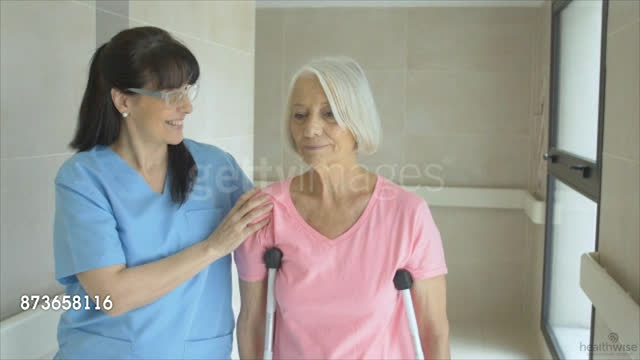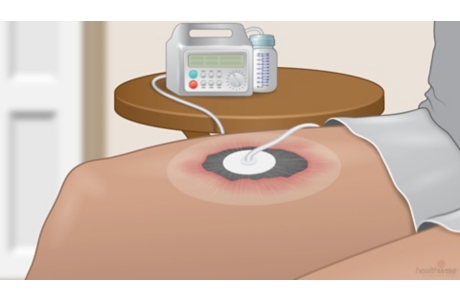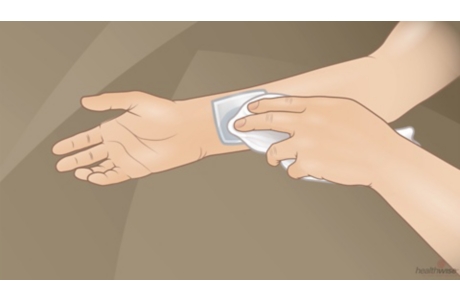Pressure Injuries
Condition Basics
What are pressure injuries?
A pressure injury on the skin is caused by constant pressure to that area. The pressure damages the skin and underlying tissues, creating an injury. This can happen when you lie in bed or sit in a wheelchair for a long time.
Pressure injuries usually occur over bony areas, such as your sit bones, hips, lower back, elbows, heels, and shoulders. Pressure injuries can also occur in places where the skin folds over on itself, or where medical equipment presses on the skin, such as when oxygen tubes press on the ears or cheeks.
Pressure injuries can range from red areas on the surface of the skin to severe tissue damage that goes deep into muscle and bone. Severe injuries are hard to treat and slow to heal. When pressure injuries do not heal properly, problems such as bone, blood, and skin infections can develop.
What causes them?
Pressure injuries are caused by constant pressure on the skin and tissues.
Other things that can make pressure injuries more likely include:
- Sliding down in a bed or chair (shear force).
- Being pulled across bed sheets or other surfaces (friction).
- Not getting enough nutrition to keep your body working well (malnutrition).
- Not being able to get out of bed or walk around (immobility).
- Having a disease that affects how well blood circulates in your body, such as diabetes or peripheral arterial disease.
- Excess moisture, such as from sweat, urine, or feces. Skin that is often wet is more likely to break down and form pressure injuries.
What are the symptoms?
At first, the skin may appear reddened. Or the skin may look purple or dark red. In darker skin, the color may differ from that of nearby skin. The injury may be tender and warm to the touch. It may break open or form an ulcer where fat, bone, or muscle may be visible.
How are they diagnosed?
A doctor can diagnose a pressure injury by examining it. In some cases, the doctor may want to do blood tests to check for infection or to see if you're getting enough protein in your diet. The doctor may also want to do a skin and wound culture or a skin biopsy.
How are pressure injuries treated?
Treatment focuses on helping the pressure injury heal. This involves keeping pressure off the area. Injuries with unbroken skin may need to be kept clean and bandaged. For open injuries, your doctor may remove dead tissue from the wound to prevent an infection. You may need special dressings. Some people may need surgery.
Prevention
Relieving and spreading out pressure is the most important part of both preventing and treating pressure injuries. Putting pressure on one spot for long periods of time damages the skin and underlying tissues. Pressure can be relieved and spread in several ways. Often a combination of these is best.
- Change position often.
- In a bed, change position every 2 hours. Learn how to move yourself so that you avoid folding and twisting your skin.
- In a wheelchair or other type of chair, shift your weight every 15 minutes.
- Try not to slide or slump across sheets in a chair or bed. Recliner chairs are likely to allow slipping, so don't sleep in a recliner. Try to keep the head of a bed, a recliner chair, or a reclining wheelchair raised no more than 30 degrees.
- Take good care of your skin.
- Bathe as often as needed to be clean and comfortable. Use gentle soap, and use warm (not hot) water. Be careful not to scrub the skin too hard.
- If you have problems with bowel or bladder control, clean your skin right away if it gets soiled or wet. Use a protective barrier cream, lotion, or ointment to protect your skin from wetness. Use pads or briefs that absorb moisture and pull it away from your skin.
- If you have dry skin, use moisturizing cream or lotion to keep your skin from drying out and cracking.
- Check your skin every day for signs of pressure injuries. Pay special attention to bony areas such as the hips, elbows, knees, and heels. Also watch for pressure from sources such as:
- Body parts or skin folds, especially if you're overweight.
- Chair arms, parts of wheelchairs, braces, or other places where you rest your elbows or other body parts.
- Medical equipment such as oxygen masks or oxygen tubing.
- Make healthy choices.
- Eat healthy foods with enough protein, and get plenty of fluids (unless your doctor has told you to limit your fluid intake). That can help damaged skin heal and help new skin grow.
- If you smoke, quit or cut back as much as you can. Talk to your doctor if you need help quitting. Smoking dries the skin and reduces blood supply to the skin.
- Talk to your doctor about pressure-relieving cushions and pads.
- Use special support surfaces. There are mattresses, bed covers, and chair cushions designed to help reduce and spread pressure.
- Ask your doctor which cushions and pads might help you. Some products, such as doughnut-type devices, may actually cause pressure injuries or make them worse.
If you or someone you care for is not able to move much, it's important to prevent pressure injuries and to check the skin every day. If you think that a pressure injury is forming, take steps to treat it. Talk to your doctor or nurse about what more you can do.
Learn more
Watch
When to Call a Doctor
Call your doctor now or seek immediate medical care if:
- You have signs of infection, such as:
- Increased pain, swelling, warmth, or redness.
- Red streaks leading from the sore.
- Pus draining from the sore.
- A fever.
Watch closely for changes in your health, and be sure to contact your doctor if:
- Your pressure injuries are not healing.
- You have new pressure injuries.
Treatment Overview
Treatment focuses on preventing a pressure injury from getting worse and on making the skin healthy again. It may include:
- Taking pressure off the area, changing positions often, and spreading body weight evenly with special mattresses, pads, or other support.
- Keeping the wound clean and covered with a bandage. The doctor will tell you how to care for your wound. You may need to keep the wound a little moist and not let it dry out between bandage changes.
- Eating a healthy diet with enough protein.
- Having debridement. This is when the doctor removes dead tissue from the wound to promote healing.
- Having surgery. Severe pressure injuries may be treated with surgery. A tissue flap or skin graft may be needed.
Negative-pressure wound therapy, also called vacuum-assisted closure, may be used to help with healing.
Researchers continue to study these and other treatments for wounds, including electrical stimulation, hyperbaric oxygen therapy, platelet-derived growth factor, and ultrasound therapy.
Watch
Self-Care
- Change positions often. For example, change positions about every 2 hours when lying down and every 15 to 30 minutes while sitting. Try setting a timer to remind yourself.
- If your doctor prescribed a medicated ointment or cream, use it exactly as prescribed. Call your doctor if you think you are having a problem with your medicine.
- Wash pressure injuries every day, or as often as your doctor recommends. Most tap water is safe, but follow the advice of your doctor or nurse. They may recommend that you use a saline solution. This is a salt and water solution that you can buy over the counter.
- Put on bandages as your doctor or wound care specialist says.
- Keep healthy tissue around the sore clean and dry.
- Check your skin every day for sores (or have a caregiver do it).
- If you know what caused the injury, find a way to remove that pressure.
Watch
Credits
Current as of: November 16, 2023
Author: Healthwise Staff
Clinical Review Board
All Healthwise education is reviewed by a team that includes physicians, nurses, advanced practitioners, registered dieticians, and other healthcare professionals.
Current as of: November 16, 2023
Author: Healthwise Staff
Clinical Review Board
All Healthwise education is reviewed by a team that includes physicians, nurses, advanced practitioners, registered dieticians, and other healthcare professionals.
This information does not replace the advice of a doctor. Healthwise, Incorporated, disclaims any warranty or liability for your use of this information. Your use of this information means that you agree to the Terms of Use. Learn how we develop our content.






